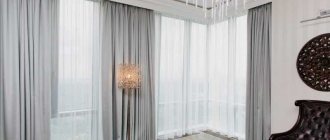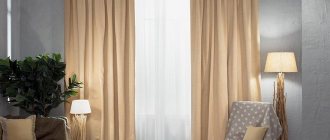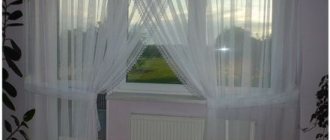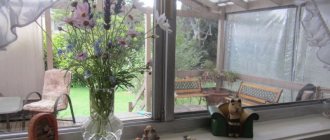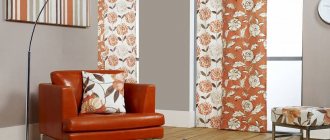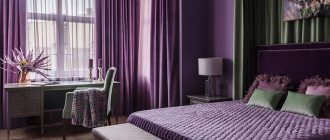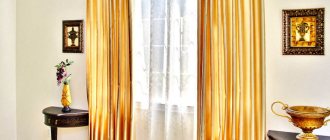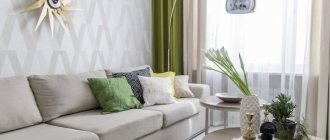Why do you need to tie curtains?
Using a special decor, you can quickly and easily redesign the window opening. Such accessories include: hairpins, clips, hooks, ties, garters. They are capable of:
- focus attention on the curtain;
- create an attractive drapery;
- become a connecting link if you need to moderately complement the interior with some shade or combine the curtain with the decorative elements of the room.
The fabric for curtains must have the appropriate characteristics.
When choosing them, you need to pay attention to the material from which the curtain is made, the overall design of the room and personal preferences. In a classic interior, garters and laces with tassels would be appropriate. In rustic, country and Provence, hairpins decorated with a bow or floral arrangement, ribbons, braid and lace are suitable.
Recently, window decoration with roller blinds and tulle has become very popular.
When decorating a room in a minimalist or high-tech style, you should choose a metal or plastic hairpin. Wooden details and coins will look ideal in ethnic design (Moroccan, African, Arabic).
Decor stores sell different models of this accessory.
In addition to the aesthetic issue, the tie can also solve a practical one, changing the visual perception of the window. In the event that the length of the selected curtain turns out to be inappropriate, the problem can be corrected by tying it up beautifully:
- By picking up the curtain high, almost near the cornice, attractive folds will appear on the fabric. In this case, the window opening will appear wider. This mounting option is used for those curtains that almost never open.
- By tying both fabrics symmetrically, you get a spectacular composition.
- Placing the garter in the lower third of the curtain will make the window appear wider
- For curtains that are too long, you can use several clamps at once, placed on both canvases at different levels, forming puffs on the curtain.
The Austrian curtain is assembled only at the bottom.
Curtains with ties have a number of advantages:
- the ability to adjust the level of illumination in the room;
- giving the room uniqueness and elegance;
- ease of use;
- the ability to hide window imperfections;
- ability to fit into almost any interior.
High-tech and modern styles can also be decorated with such curtains.
Curtain garter techniques
Hanging curtains and tying curtains determines their place in the design. If you do this ineptly, you can end up with an elaborate and unaesthetic detail that is not at all necessary. But it's not as difficult as it might seem.
Before gartering, you need to study several factors:
- Design of a combined kitchen-living room: zoning and styles (110 photos)
- How to decorate walls inside a house - the best ideas, materials and examples of use with photos
Curtains for the living room - 80 design photos. Recommendations for choosing!
1. Fabric type. It is desirable that the tiebacks be made of the same material, complementary or related.
2. Weight. If you need to direct the curtains to one side and the fabric is too heavy, a light tie will not hold it. Therefore, for example, classic heavy curtains are tied with a thick decorative cord that can support them.
3. Interior. Pickups are not peripheral. It is at the forefront of the interior, so they are required to fit well.
If we talk about the technique itself, there is nothing complicated here. Basic techniques 2:
- For very long curtains, it is advisable to use a multi-level tie. That is, at a certain interval you need to install ring strips in order to build an even slope. For very long curtains, one garter will not work. They will fold unevenly. Although this is appropriate in some styles, in general it only disfigures the curtains.
- One garter on the window sill will help to visually expand the window opening with medium curtains. By the way, if the curtains are drawn on one side, then it is easier to regulate the amount of light this way.
- Short curtains are fastened well with thin tiebacks. They are often made with buttons.
You can see what these techniques look like in the photo below.
How to choose curtain garters
When choosing tiebacks, you need to pay attention to ensure that they are harmoniously combined with the curtain itself, the decoration of the room and other decor that is used here.
The design of the room will depend on the type of methods and devices for hanging and fasteners.
Rigid and flexible
Soft fabric holders can match the shade of the curtain or contrast with it. In addition, they must be combined with the shade and design of the cornice. The shape of garters can be classic, braided, straight or cone-shaped. Based on the general style of the room, ruffles, frills and lace ties are used.
Lovers of the classics prefer symmetrical draperies.
To emphasize the original design of the curtains, they are decorated with ornaments, embroidery, beads, themed tiebacks - for decorating the kitchen, reminiscent of fruits or for a children's room - small soft toys.
Even the most inconspicuous curtains will be transformed and look stylish if you choose the right garters for them.
Among the soft types, brushes and cords decorated with glass beads, metal and plastic parts are distinguished separately. Hard models can be metal hooks or hairpins. The hooks are made in the form of a loop, which is attached to the side of the window.
Non-standard
They can have the shape of a flower, an animal, a geometric figure, etc. For their production, wood, metal, straps, ropes, and improvised materials (lace, macrame) are used.
Use different materials to tie curtains.
Hairpins
Hairpins are a retainer or suspension. They catch the fabric in the right place, creating an exquisite drapery. Their choice depends on the fabric used for sewing curtains and interior details. They should be combined with the cornice, door handles, and other decor of the room.
A hairpin can decorate a curtain.
Magnetic
Ideal for draping thin fabrics. This holder is a strip with magnets at the ends. The front side of the magnetic garter is decorated with metal elements and stones.
From beads
Depending on the density of the curtain, bead holders are chosen. A light curtain can be held up by small beads collected in several rows.
Fits into any interior and style.
For curtains, choose large beads on fishing line or thick thread. Additional decoration can be medallions, hand weaving (kanzashi).
Garters with tassels
When choosing ties for the bedroom or living room, you should pay attention to models with tassels on a cord. For the bedroom, it is better to take a pick-up with a large brush, the shade of which will repeat the color of the wall decoration.
If there are flaws in the window opening, you can hide them with the help of tiebacks.
In the living room, contrasting color options look good. They may also differ in texture and other parameters.
Ways to beautifully drape curtains
Professional designers masterfully form folds by hand. The fabric is pre-sewn, eliminating the possibility of damage to the structure of the assemblies over time. The labor-intensive method of manually draping curtains pays off with reliability and long service life.
One curtain can be draped in several ways at different times, and it will look different, creating the illusion that the textiles have been replaced. Ornate flowing folds of translucent tulle framed by jacquard, silk or tapestry evoke a feeling of admiration.
We present just some types of curtain drapery:
Curtain tape is a good assistant in draping curtains. It is sewn from the inside out and can be made of mesh or textile. By pulling it, you can create beautiful vertical folds. The curtains are fixed to the curtain rod with hooks. The width of the canvas must be several times longer than the cornice. Folds are formed at selected intervals.
In order for the curtain display to give the room an original chic and create a harmonious ensemble, you should take into account the depth of the folds and buy the amount of fabric according to the multiplicity of the assembly. To achieve the effect of rich drapery, the length of the curtain should be 3 times the length of the assembled braid.
The width of the tape can be different, which will satisfy any wishes and preferences. With the help of braid, both draped tulle for a small kitchen and heavy curtains in the living room stand out against the general background.
You may also be interested in: How to hang curtains beautifully
To create drapery, you can use tiebacks, classically collecting curtains from the sides at the level of the window sill or below, symmetrically or asymmetrically. A winning interior composition is created, the perspective of the view from the window opens, and the regulation of penetrating natural light is formed.
Even simple plain curtains will look solemn if you complement them with decorative tiebacks. A unique and cost-free method of draping can be achieved by hanging the curtains in parallel, without moving them apart, moving them apart, and securing them with tiebacks.
How to tie curtains yourself
Photos of options on how to beautifully tie curtains with your own hands demonstrate the variety of options. When choosing a method for attaching the holder, you need to take into account the location of the window, the fabric from which the curtain is made and the number of panels.
You can make your own curtain garter.
Various knots and bows are called universal options.
Double curtain
Let's look at how to tie curtains consisting of two panels. There are several ways to beautifully fix two curtains at once:
- Symmetric. The ties are placed at the same level on both sides. This technique will make the interior harmonious. To make the window look strict, the fabric is left taut. If you spread it out a little in a semicircle, the decor of the room will look romantic.
- Asymmetric. In this case, the hairpins on the sides of the window opening are placed at different heights. As a rule, one of them is level with the window sill, the second is slightly higher or lower. This technique will make the room non-standard and visually expand the wall. In addition to different levels of placement of holders, their shade or shape may differ.
- Angular. In this case, the edges of the curtain are gathered in the middle and moved to the side, securing the fabric to the wall. This will create a tent effect, and the window will be partially open. This method is recommended to be used for double-sided fabrics. It will look especially impressive if the canvases have contrasting shades (white with black, gold with red).
- Cross. Each of the panels is attached to the opposite side of the window. This looks good with colorful curtains made from light fabrics. You can tie muslin using the same method.
Single curtain
To secure one curtain, a tie located in the middle is suitable. If the curtain has neutral shades, then the garter can be decorated with stones and other decorations. If there is a pattern on the fabric, then the color of the holder should match the shade of the main background or the color of the ornament.
They add elegance, solemnity and uniqueness to the room.
Curtains can be tied at the desired height using a knot. If it is high, it will visually make the window more elongated. A single panel can be assembled on one side of the window using a rigid fastening, which hides the fabric pick-up.
If the fabric has calm colors, then you need to use a bright tie.
Another option is to lift one side of the canvas diagonally, partially opening the window.
A variety of types and options for an ever-fashionable accessory
Traditionally, curtain tassels are a bunch of threads with loose ends, tied in the middle or upper part. Organza, wool, cotton or synthetic threads are used to construct them. Decorative elements can include: threads of beads, glass beads, crystals, carved wooden parts, complex jewelry inlaid with “precious” stones and metals.
Based on the type of purpose, the following types of products are distinguished.
- Decorative elements that are sewn to lambrequins or swags.
- Small tassels are used to decorate the fringe that trims the edges of the curtains.
- Original tiebacks are made from decorative twisted cords with tassels.
- Often large curtain tassels are repeated on the borders of pillows, but in a smaller form. This allows you to create a harmonious and complete image.
The variety of materials, colors and textures allows you to create jewelry that is unique in its design. In addition to traditional options, avant-garde, non-standard and unusual products are becoming increasingly popular.
Advice
In order for the ensemble, which includes curtains and tiebacks with tassels, to look harmonious and appropriate, the fittings must be selected in accordance not only with the style, but also with the status of the curtains. Luxurious curtains, “belted” with cheap cords, will look more than modest, even if you tie original knots. At the same time, light and flowing curtains accompanied by heavy ropes with massive tips will look rude and tasteless.
Application of curtains with ties in the interior
Curtain ties can give your interior an elegant look.
The choice of mounting option and method of garter depends on the room:
- Translucent curtains with a loop look beautiful in the living room. If the interior is made in a classic style, it is allowed to allow the fabric to sag and folds to form.
- The bedroom should be reliably protected from bright sun. Therefore, here curtains with ties can be combined with thick curtains. Mounts decorated with bows and beads will look original.
- In the nursery, curtains are decorated with hairpins, beads, bows, and toys.
- How to tie curtains in the kitchen beautifully? Holders whose texture and color contrast with the canvas will look interesting.
Curtains in the nursery should be securely fastened and should not drag on the floor.
The use of various holders allows you to easily transform the overall appearance of the room, improve its illumination and change the geometry of the window opening. When choosing an accessory, it is important to pay attention to the type of curtain, the style of the room, the shades used in the decoration and decoration of the room. Due to the fact that there are many options for tying curtains, you can change the look of the window structure at any time.
How to create curtain tassels with your own hands?
As practice shows, a product created at home often looks even more attractive than a purchased one. The range of professionally made accessories is very wide and allows you to choose the optimal decor option for any curtains and the most intricate interiors. But hand-made tiebacks and tassels allow you to match the fittings to the color of the curtains as accurately as possible. As a result, the image looks complete and complete.
For creativity you will need yarn, a piece of cardboard, a wooden ring and ball, and glue. There are very simple instructions that will help you create an original and attractive decorative element with your own hands.
- Cut out a rectangle from cardboard. The size of the stencil depends on the desired size of the product.
- We wrap yarn, such as thick wool, around the resulting frame. The more turns, the more magnificent and rich the “skirt” of our curtain brush will be.
- We thread the free ends of the thread under the layer of wool and bring it out at the top. We tie the threads tightly, and cut the entire structure evenly at the bottom.
- Remove the “skirt” from the stencil and tie it tightly at the top. This end will be attached to a ring or ball, so it should be as tight and narrow as possible.
- We carefully wrap the ball and ring with selected yarn so that there are no gaps left. For better work, the ball and ring can be coated with glue in some places, so the threads will not move.
- We roll the cord or use a ready-made one. There should be a free thread on the side where it will connect to the main structure.
- We tie the cord to the “skirt” with a loose thread and thread it first through the ring, then through the ball. The structure can be further secured using slightly heated glue.
- We cut off all protruding threads; if gaps have formed, we cover them with fringe or braid. The accessory is ready.
If desired, homemade curtain tassels can be further decorated with beads, rhinestones, glass beads - often the fittings are simply glued on. Often, not one, but several types of yarn are used. The weaves of metal threads look beautiful.
Another undeniable advantage of homemade jewelry is its low price. Professional products are quite expensive, but accessories made from similar fittings, created by yourself, are several times cheaper.
Curtains with suspenders in the interior in the photo
Photo
Note! Living room in Art Nouveau style - 125 photos of a magnificent living room
Let's discuss this article together:
Click to cancel reply.
Peculiarities
Drapery can hide architectural defects, change the proportions of a room, and give it a special style and charm. Using draperies on the window, you can regulate the lighting in the room, emphasize the beautiful view from the window, or, conversely, hide a not-so-attractive landscape. Curtains made of heavy fabrics will protect the sun's rays and curious passers-by, while curtains made of light fabrics will make the room airy and bright.
It is recommended to have two sets of curtains: one for winter, the other for summer.
Decorating a window opening with draperies provides wide scope for creativity. Combinations of fabrics of various textures and shades allow you to create a sophisticated and stylish interior, placing emphasis on the decorative decoration of the room.
When starting to decorate a window opening, you should consider the following factors::
- The drapery should fit harmoniously into the surrounding space, emphasizing its style. It should have such qualities as practicality, style and ease of layout.
- When choosing the shade and texture of the fabric, you should take into account the lighting of the room, the height of the ceiling and the size of the window opening (large, small, tall, narrow).
- The abundance of folds looks good in a room with high ceilings. If the ceiling is low, you should not overuse draperies.
Winter drapery is made from dense fabrics that retain heat well. For the summer option, a thin translucent fabric that is resistant to fading is suitable.
- You can't skimp on fabric. Curtains that do not reach the floor by a few centimeters will look less impressive. When choosing the width of the curtains, you should be guided by the principle: the canvas should be three times wider than the cornice.
- Light fabrics will make the interior airy and delicate; they are suitable for any room. Massive curtains with an abundance of decorative elements should be used with caution; they evoke an association with the theater. It is better to hang such curtains in large rooms. Fabrics such as organza and voile allow you to create complex drapery options without weighing down the room.

